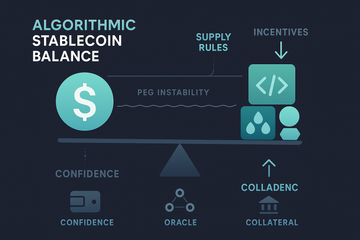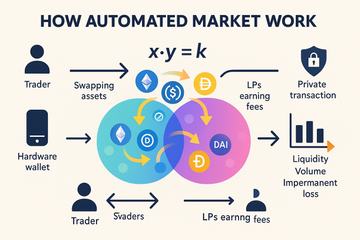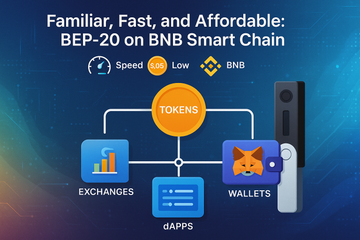Algorithm sounds like a heavy word, but the idea is simple. It is a set of clear steps that you follow to get a result. Boil water, add coffee, pour slow, stir. That is an algorithm. In crypto, we use algorithms to turn random numbers into keys, keys into signatures, signatures into valid transactions. The order matters. Change it, and you change the outcome.
You know what? Most of us already think in steps. We set phone alarms, check prices, stash cold storage, maybe run a quick sanity check on a seed phrase. That is all process. The only twist is that in crypto, small mistakes can be costly. So it helps to learn what these steps actually do, even at a high level.
So what is an algorithm, really?
Think of an algorithm as a recipe with no guesswork. Each instruction is clear, and it has to run in a certain order. Start from input. Process it with known steps. End with output. If two people follow the same steps, they get the same result. That is why good algorithms feel reliable. They do what they say, and they do so every time.
In crypto, that predictability is gold. You want a signature to verify the same way, now and ten years from now. You want a seed phrase to derive the same keys across wallets. You want a hash to be stable. The magic is repeatability, not luck.
From grocery lists to blockchains
Let me explain with a detour. Your morning routine has algorithms. Put on kettle. Grind coffee. Rinse filter. Brew. Taste. Adjust. These steps keep your coffee consistent. If you reverse the steps, you get chaos. It is the same with code.
On a blockchain, nodes process blocks with strict rules. Transactions go in, each is checked, then ordered. Miners or validators follow a clear process, again and again. If someone bends a rule, the network rejects it. That shared discipline is what makes a public ledger hold up under pressure.
Why order matters, especially for crypto
Change the order, break the result. Hash first, sign later, then broadcast. Not the other way around. When a wallet builds a transaction, it selects inputs, sets outputs, estimates fees, then signs. Mix those up and you risk extra fees or invalid signatures. Fee spikes during a Bitcoin halving? A good fee algorithm adapts to mempool congestion. A sloppy one leaves you hanging. Order keeps calm when the network gets hot.
Hashing, keys, and signatures, in plain words
Let us keep this simple and honest.
- Hash functions: A hash is a short fingerprint of data. Change one letter, get a totally different print. Bitcoin uses SHA-256. Ethereum leans on Keccak. Hashes help secure blocks, addresses, and proofs.
- Key generation: Your private key starts as a big random number. A good random source matters. Hardware wallets use secure chips and trusted randomness, not a dice roll in your head.
- Signatures: ECDSA on secp256k1 is common in Bitcoin. Ed25519 shows up in other networks. A signature proves you own the key, without revealing the key. That is the neat part.
- Key stretching: PBKDF2, scrypt, and Argon2 slow down brute force. They turn a passphrase into stronger material. It is like adding friction for attackers.
Each of these is an algorithm with steps that must be exact. No fuss. No missing piece.
Wallets run on algorithms, not vibes
When you use a hardware wallet, you are trusting a stack of algorithms under the hood. BIP39 turns randomness into a 12 to 24 word seed. BIP32 and BIP44 define paths that derive keys for each account and coin. If you ever restored a seed on a new device and saw your coins appear, that was the beauty of shared rules. The steps align across brands.
Ledger and Trezor follow these standards. Trezor is known for open source firmware and, if you like, Shamir backup with SLIP-39. Ledger uses a secure element chip with strong isolation, plus support for a wide set of chains. Different philosophies. Shared math. Both rely on precise steps that have stood up to public review.
Seed phrases, explained without the fog
Those 24 words are not random poetry. They are a human-readable format for a big number. The list comes from a wordlist with checksums, so typos are easier to catch. Add a passphrase, and you get a hidden vault. Same seed, different secret. It is a clever trick. If someone finds the words, they still need the passphrase. That extra step, when used well, adds real safety.
Building a transaction, one step at a time
A wallet builds a transaction like this. Pick UTXOs or inputs. Set outputs and change. Estimate a fee from current mempool data. Construct a raw transaction. Review on device. Sign inside the secure environment. Broadcast to the network. Each step stands on code that has been hammered by years of use, and it should be clear and testable.
Bitcoin users might see PSBT, which lets software and hardware split the job in clear steps. Ethereum users see nonce handling and gas estimators. Same spirit. Different details. If fees jump during an ETF news surge, better algorithms help you avoid stuck transactions.
Security is a moving target, but math stays steady
Firmware updates patch bugs. Side channel defenses protect against tricky attacks. Constant time code helps guard against timing leaks. Good wallets lean on simple rules, strong defaults, and regular reviews. Trezor publishes code and invites eyes. Ledger places secrets in a secure element and uses clear screens for final checks. Two roads, similar goals.
There is no perfect choice, only tradeoffs. Open review can catch issues early. Secure silicon can harden physical security. Many users like both, for different reasons. Honestly, what matters most is that the steps are sound and the team treats updates with care.
Trend watch, from AMMs to account abstraction
DeFi runs on algorithms too. Automated market makers use the x times y equals k rule to set prices. No haggling. Just math. Order flow routers, price oracles, liquidation bots, all of it follows steps that run non-stop. With gas fees rising during rush hours or meme coin frenzies, smarter estimators and batching can save real money.
On Ethereum, account abstraction with EIP-4337 brings smart account logic. Think session keys, social recovery, and custom rules. Underneath, bundlers and paymasters follow strict steps. Hardware wallets are catching up with standards that let them sign these flows in a clear, safe way.
How to judge a wallet by its algorithms
You do not need to read source code to ask good questions. Small checks go a long way.
- Standards: Does it support BIP39, BIP32, BIP44, and PSBT where needed?
- Randomness: Does it seed with a strong source and allow test vectors or self checks?
- Recovery: Can you restore on another brand, like Trezor or Ledger, without trouble?
- Firmware updates: Are updates signed, and is the process clear and reversible?
- Security model: Open firmware with public review, secure element with tight access, or both?
- Extras: Passphrase support, multisig, and well explained prompts on the device screen.
Good habits are human algorithms
Here is the thing. Even perfect code cannot save you from poor habits. Write down your seed offline. Use a passphrase you can remember yet no one can guess. Test recovery before you store real value. Use multisig if it fits your life. Separate hot funds for daily moves from cold funds for long holds. Repeat these steps. Build a rhythm. It feels simple, because it is simple.
A tiny contradiction, then a fix
People say code is math, and math does not care about moods. That is true. Yet humans build and use these systems, and we have moods, and we make mistakes. The fix is to design clear steps that guide us toward safe choices. Confirm on the device. Slow down for big sends. Read the address out loud. Small rituals help.
One last thought before you hit send
Algorithms are not distant theory. They are practical steps that keep your money safe. From SHA-256 to a simple seed check, from a Ledger secure element to a Trezor open review, these systems rely on clarity. When you understand the steps, even a little, you feel calmer during market storms. You can pause, breathe, and still move with purpose.
So keep a short checklist. Keep your habits tight. And when your device asks you to confirm that final screen, trust the process you built. It is just another algorithm, and you know how to follow one.











